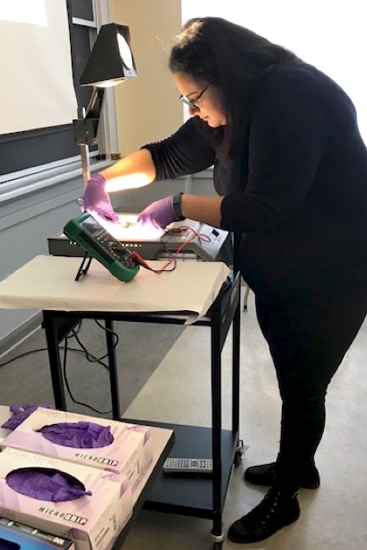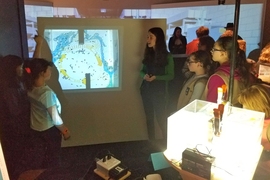The Materials Research Science and Engineering Center (MRSEC) at the MIT Materials Research Laboratory hosted 26 high school girls from the greater Boston area last month for lunch and a science-and-engineering project building dye-sensitized solar cells. The participants were a subset of about 150 girls attending the day-long Science, Engineering, and Technology (SET) in the City program sponsored by the Boston Area Girls STEM Collaborative.
The girls were led by three MRSEC graduate students and eight undergraduate members of the MIT Society of Women Engineers. The solar cell activity involved staining a conductive glass slide with a thin film of titanium dioxide (TiO2) and raspberry juice. A second slide was coated with graphite. After clipping the two slides together, an electrolyte solution was applied. The girls measured the voltage and current output of their cells by attaching them to a multimeter.
The day-long SET in the City program began at Boston University with two kickoff speakers: a chemistry professor from Simmons University and a scientist from Cellino Biotech. This was followed by a “Science Information Bazaar” featuring tabletop demonstrations, posters, exhibits, and computer applications presented by students from member universities.
The 150 high school participants then divided into five sections, each bused to a different venue for lunch and a science/engineering activity. The five locations were MIT, Harvard University, Emmanuel College, Biogen, and Simmons University. After the activity, the entire group reconvened at Merck Research Laboratories in Boston for a keynote address by two Merck scientists titled “Shaping the Future of Research: Innovation and Discovery into Clinical Breakthroughs.” A panel of five college and graduate students ended the program by sharing their passion for science and engineering, and describing their college and university experiences.
The Boston Area Girls STEM Collaborative is a group of women representing local nonprofit organizations, colleges, and universities who are committed to increasing young women’s participation in science, technology, engineering, and mathematics. SET in the City is one of the programs developed by the collaborative to offer girls opportunities to learn more about STEM while interacting with female role models. This was the 11th year that SET in the City was offered.









